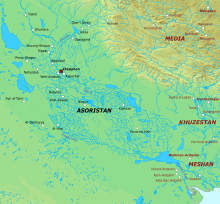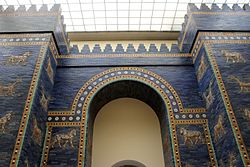Asoristan
30°53′41″N 47°34′41″E / 30.89472°N 47.57806°E
| Asōristān | |||||||||
|---|---|---|---|---|---|---|---|---|---|
| Province of the Sasanian Empire | |||||||||
| 226–637 | |||||||||
 Map of Asoristan and its surrounding provinces | |||||||||
| Capital | Ctesiphon | ||||||||
| Historical era | Late Antiquity | ||||||||
| 226 | |||||||||
| 633 | |||||||||
| 637 | |||||||||
| |||||||||
| Today part of | Iraq | ||||||||
| History of Iraq |
|---|
 |
|
|
Asoristan or Beth Aramaye[1] (Middle Persian: 𐭠𐭮𐭥𐭥𐭮𐭲𐭭 Asōristān, Āsūristān) was the name of the Sasanian province of Assyria and Babylonia from 226 to 637.[2][3]
Name[edit]
The Parthian name Asōristān (𐭀𐭎𐭅𐭓𐭎𐭕𐭍; also spelled Asoristan, Asuristan, Asurestan, Assuristan) is known from Shapur I's inscription on the Ka'ba-ye Zartosht, and from the inscription of Narseh at Paikuli.[2] The adjective āsōrīg in Middle Persian accordingly means "Babylonian".[2] The region was also called several other names, In Aramaic the region was called Beth Aramaye lit. “land of the Arameans”.[2][1] (Classical Syriac: ܒܝܬ ܢܗܪܝܢ), Bābēl / Bābil, and Erech / Erāq. After the mid-6th century it was also called Khvārvarān in Persian.
The name Asōristān is a compound of Asōr (Babylonian") and the Iranian suffix -istān ("land of"). The name Babylonia, in the form Asōristān, was shifted to include what had been ancient Babylonia by the Parthians, and this continued under the Sasanians.[4] During the Parthian Empire much of the historical country of Assyria (Athura), however, lay to the north of Asoristan, in the independent Assyrian frontier provinces of Beth Nuhadra, Beth Garmai, Adiabene, Osroene and Assur, when these were conquered by the Sassanid Empire in the mid 3rd century AD these were reincorporated into Asoristan.[5]
Administration[edit]
Asōristān was devided into 12 greatest districts in Middle Persian known as kūra or ōstān, while smaller districts were called rustāk. while every small district composed of 4 quarters, tasūk, Tasūg or Tasuj in Middle Persian. The province composed of 60 tasūk. The kūra or ōstān (greater districts) of Asōristān were Holwan or Hulwan located in the north, Shad-kawad, Shad-Hormizd and Bazigan-khosrow in the east, Shad-Bahman and Shad-Shapur located in the south, on the tigris and Euphrates plain, Ardashir-Papagan, Upper-Weh-Kawad, Middle Weh-kawad and lower Weh-Kawad ōstān were located in the west of Asōristān.[6][2][7]
The smallest unit of administration was Deh "village" in Middle Persian.[7]
History[edit]
Asōristān, Middle Persian "Babylonia",[2] in Aramaic was called Bēṯ Āramayē, "land of Arameans". Asōristān was the capital province of the Sasanian Empire and was called Dil-ī Ērānshahr, meaning "Heart of Iran".[3] The city of Ctesiphon served as the capital of both the Parthian and Sasanian Empire, and was for some time the largest city in the world.[8] The main language spoken by the Arameans and jews was Eastern Aramaic, with the local Syriac language becoming an important vehicle for Syriac Christianity. The Assyrian Church of the East was founded in Asōristān and it was an important centre of the Syriac Orthodox Church.[9] Asōristān was largely identical with ancient Mesopotamia.[2] The northern border is somewhat uncertain but probably went along a line from Anta[where?] to Takrīt. Ḥīra was probably the southernmost point, north of Arabia, the border then following the northern part of the swamps of Wasit.[2]
Population[edit]
The population of Asorestan was a mixed one, the Arameans who spoke eastern Aramaic dialects made up the majority of the population.[2] The Greek element in the southern cities, still strong in the Parthian period, was absorbed by the Arameans, Arabs and jews in Sasanian times.[2] the Arabs of Asoristan were Nomadic lived in the vicinity of the province's desert. The Iranians were the higher classes of society. Persians lived in various parts of the province; Persian garrison soldiers lived along the outer fringe of southern and western Asoristan, Persian noble families lived in the major cities, whilst some Persian peasants lived in the villages in the southern part.[10][2] the Jewish population spoke a western Aramaic dialect, were mainly farmers, but a minority were city dwellers.[2]
Language[edit]
The majority of Asoristan population spoke western Aramaic dialects.[2]
Religion[edit]
The religious demography of Mesopotamia was very diverse during Late Antiquity. From the 1st and 2nd centuries Syriac Christianity became the primary religion, while other groups practiced Mandaeism, Judaism, Manichaeism, Zoroastrianism, and the ancient Assyro-Babylonian Mesopotamian religion.[11] Assyrian Christians of the Syriac Orthodox Church and Assyrian Church of the East were probably the most numerous group in the province.[11]
Mesopotamian religion[edit]
The old Mesopotamian religion of the indigenous Assyrians and Babylonians remained strong in places, particularly in the north, in Assyria proper. Temples were still being dedicated to Ashur, Shamash, Ishtar, Sin, Adad/Hadad, Tammuz, Nergal, Bel and Ninurta in Assur, Arbela, Edessa, Amid, Nohadra, Kirkuk, Sinjar, Nineveh Plains, and Harran among other places, during the 3rd and 4th centuries AD, and traces would survive into the 10th century in remote parts of Assyria.[12]
Christianity[edit]
Asorestan, and particularly Assyria proper, were the centers for the Church of the East (now split into the Assyrian Church of the East, the Ancient Church of the East and the Chaldean Catholic Church), which at one time extended far beyond the confines of the by then defunct Sasanian empire and was the most widespread Christian church in the world, reaching well into Central Asia, China, Mongolia Tibet and India as well as the Aegean. It sees as its founders the apostle Thomas (Mar Toma), and Saint Thaddeus (Mar Addai), and used the distinctly Syriac version of Eastern Aramaic for its scriptures and liturgy. The Holy Qurbana of Addai and Mari is one of the oldest Eucharistic prayers in Christianity, composed around the year 200 AD. The Church of the East was consolidated in 410 at the Council of Seleucia-Ctesiphon, held at the Sasanian capital, Selucia-Ctesiphon, which remained the seat of the Patriarchate of the Church of the East for over 600 years.
Mandaeism[edit]
The Mandaeans, who are according to their traditions the original followers of John the Baptist, are the last surviving Gnostics from antiquity.[13] According to most scholars, Mandaeism originated sometime in the first three centuries CE, in either southwestern Mesopotamia or the Syro-Palestinian area.[14] However, some scholars take the view that Mandaeism is older and dates from pre-Christian times.[15] Mandaeans assert that their religion predates Judaism, Christianity, and Islam as a monotheistic faith.[16] Their language and script is Mandaic, a form of Aramaic. Two of their important religious texts, written between the 1st and 3rd centuries, are the Ginza Rabba and the Mandaean Book of John (preserving original traditions about John the Baptist). The Mandaean population numbers between 60,000 and 100,000 today.[17] Mandaeism flourished in the Parthian and early Sassanid period in the region.[18]
Manichaeism[edit]
The religion of Manichaeism, founded by Mani (216–276), originated in 3rd century Asorestan, and spread across a vast geographical area. In some instances, Manichaeism even surpassed the Assyrian Church of the East in its reach, as it was for a time also widespread in the Roman Empire. While none of the six original Syriac scriptures of the Manichaeans have survived in their entirety, a long Syriac section of one of their works detailing key beliefs was preserved by Theodore Bar Konai (a Church of the East author from Beth Garmaï), in his book Ketba Deskolion written in about 792. Like the Church of the East, the traditional center of the Manichaean church was in Seleucia-Ctesiphon.[19] Mani dedicated his only Middle Persian writing, the Shāpuragān, to Shapur I.
Judaism[edit]
The Jewish community of Babylonia came to prominence in the 3rd century CE as a center of Jewish scholarship owing to the decline of the Jewish population in the Land of Israel. The Jewish–Roman wars, the Crisis of the Third Century, and Rome's conversion to Christianity all led to an increase in Jewish immigration to Asoristan, and the region became the main center of Judaism in Late Antiquity. This set the stage for the composition of the major book defining Rabbinic Judaism, the Babylonian Talmud, which was written in Jewish Babylonian Aramaic in Asoristan between the 3rd and 5th centuries. The Babylonian Talmudic academies were all established relatively near to Seleucia-Ctesiphon. The first Talmudic academy was founded in Sura by Rav (175–247) in about 220. One of the most influential Talmudic teachers, Rava (270–350), who was influenced by both Manichaean polemic and Zoroastrian theology, studied in another Talmudic academy at Pumbedita.
Zoroastrianism[edit]
The Sasanian state religion, Zoroastrianism, was largely confined to the Iranian administrative class, and did not filter down to the Assyrian-Babylonian population.[11]
References[edit]
- ^ a b Michael Morony, v. Bēṯ Āramayē, in Encyclopædia Iranica, vol. IV, 1989, p. 186.
- ^ a b c d e f g h i j k l m "ĀSŌRISTĀN". Encyclopædia Iranica. Retrieved 15 July 2013.
ĀSŌRISTĀN, name of the Sasanian province of Babylonia.
- ^ a b Buck, Christopher (1999). Paradise and Paradigm: Key Symbols in Persian Christianity and the Baháí̕ Faith. SUNY Press. p. 69. ISBN 9780791497944.
- ^ Panaino, Antonio C.D.; Pettinato, Giovanni (2002). Ideologies as Intercultural Phenomena. Melammu Project. p. 76. ISBN 9788884831071.
- ^ The Encyclopedia of Military History: From 3500 B.C. to the Present, Part 25. Richard Ernest Dupuy, Trevor Nevitt Dupuy. Harper & Row, 1970. Page 115.
- ^ Nicholson, Oliver (2018). The Oxford Dictionary of Late Antiquity. Oxford University Press. pp. 1008. ISBN 9780192562463
- ^ a b Miri, Negin (2013). "Sasanian Administration and Sealing Practices". In Potts, Daniel T. (ed.). The Oxford Handbook of Ancient Iran. Oxford University Press. ISBN 978-0199733309.
- ^ Rosenberg, Matt T. (2007). "Largest Cities Through History". New York: About.com. Archived from the original on 2016-08-18. Retrieved 2012-05-01.
- ^ Khanbaghi, Aptin (2 February 2006). The Fire, the Star and the Cross: Minority Religions in Medieval and Early Modern Iran. I.B. Tauris. p. 6. ISBN 9781845110567.
- ^ Morony 2005, p. 181.
- ^ a b c Etheredge, Laura (2011). Iraq. Rosen Publishing. p. 72. ISBN 9781615303045.
- ^ J. Hämeen-Anttila Continuity of Pagan Religious Traditions in Tenth-Century Iraq
- ^ McGrath, James (23 January 2015), "The First Baptists, The Last Gnostics: The Mandaeans", YouTube-A lunchtime talk about the Mandaeans by Dr. James F. McGrath at Butler University, retrieved 14 December 2021
- ^ "Mandaeanism | religion". Britannica. Retrieved 4 November 2021.
- ^ Duchesne-Guillemin, Jacques (1978). Etudes mithriaques. Téhéran: Bibliothèque Pahlavi. p. 545.
- ^ "The People of the Book and the Hierarchy of Discrimination". United States Holocaust Memorial Museum. Retrieved 14 December 2021.
- ^ "The Mandaeans - Who are the Mandaeans?". The Worlds of Mandaean Priests. Retrieved 14 December 2021.
- ^ Buckley, Jorunn Jacobsen (2002), The Mandaeans: ancient texts and modern people (PDF), Oxford: Oxford University Press, ISBN 9780195153859
- ^ Gardner, Iain; Lieu, Samuel N.C. (2004). Manichaean Texts from the Roman Empire. Cambridge University Press. p. 43. ISBN 9780521568227.
Sources[edit]
- Morony, Michael G. (2005) [1984]. Iraq After The Muslim Conquest. Gorgias Press LLC. ISBN 978-1-59333-315-7.[permanent dead link]
Further reading[edit]
- Rezakhani, Khodādād (2018). "Mesopotamia, Persian". In Nicholson, Oliver (ed.). The Oxford Dictionary of Late Antiquity. Oxford: Oxford University Press. ISBN 978-0-19-866277-8.



